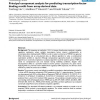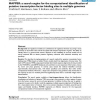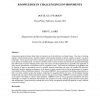1699 search results - page 339 / 340 » On the Expressive Power of QLTL |
TCOM
2008
14 years 11 months ago
2008
Recently, Multi-User Selection Diversity (MUSDiv) for single-carrier systems has been under extensive study on account of the enhancement it provides to system performance with min...
BMCBI
2005
14 years 11 months ago
2005
Background: Popular methods to reconstruct molecular phylogenies are based on multiple sequence alignments, in which addition or removal of data may change the resulting tree topo...
138
click to vote
BMCBI
2005
14 years 11 months ago
2005
Background: The responses to interleukin 1 (IL-1) in human chondrocytes constitute a complex regulatory mechanism, where multiple transcription factors interact combinatorially to...
105
click to vote
BMCBI
2005
14 years 11 months ago
2005
Background: Cis-regulatory modules are combinations of regulatory elements occurring in close proximity to each other that control the spatial and temporal expression of genes. Th...
121
click to vote
CI
2005
14 years 11 months ago
2005
Autonomous agents that learn about their environment can be divided into two broad classes. One class of existing learners, reinforcement learners, typically employ weak learning ...



